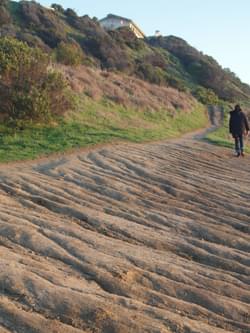




Planning Trails with Wildlife in Mind
Encouraging visitors to stay on the trail is the most important issue, and is made easier by providing attractive, well-designed trail systems. Managers should also identify populations of plants that have been designated as threatened, endangered, or sensitive.

The most readily observable impact of trail recreationists is to vegetation near trails. While these impacts tend to be very localized, they have broader implications because they alter habitat conditions and, in turn, affect wildlife. In most cases, however, these impacts to vegetation are much less than the trampling that results when there is no trail to channel people.
Of special concern should be impacts to plants that have been designated as threatened, endangered, or sensitive.
If recreationists don’t stay on trails, they tend to:
• reduce the density of plants near a trail by trampling and picking;
• compact soil and contribute to erosion;
• alter the composition of species by damaging existing plants, creating bare spots that favor exotic species, the seeds of which are introduced by trail users and their pack animals; and
• in the process, change the vertical structure and spatial pattern of vegetation.
The conditions along trails also can allow weedy, exotic plants to invade natural areas. Weeds are a problem because frequently they are more aggressive than native species and yet don’t provide the habitat that wildlife get from native species. (Typically, weeds are also less successful at inhibiting soil erosion than native plants.)
Recovery times from trampling vary widely with habitat type,with alpine ecosystems some of the slowest to recover.
In alpine ecosystems, herbaceous meadows are most quickly modified by walking, fellfields with cushion forms are less affected, and turf meadows are least affected of all. Heavy trampling will destroy a turf ecosystem in eight weeks, while a rock-desert (fellfield) will be destroyed in only two weeks.
I.1 Keeping users on trails.
In areas with sensitive vegetation, provide a well-designed trail to encourage users to stay on the trail. Use signs, educational materials, and even barriers as appropriate.
I.2 Native plants.
In natural areas, use native plants in revegetat- ing along trails because these are the plants wildlife depend upon.
I.3 Weed-free feed.
Require use of weed-free feed for horses and other pack animals so they don’t spread weeds along trails.
I.4 User education.
Educate trail users about the results of direct impacts to vegetation and indirect impacts to wildlife.
I.5 Toilets.
Provide toilets at trail-heads and other key locations to reduce damage to surrounding vegetation.
I.6 Weed control. To prevent weed spread, control aggressive weeds along trails, especially at trail-heads.
I.7 Trampling.
Design trails with proper drainage and sustainable gradients so users are less likely to trample vegetation along alternate routes.
I.8 Wet areas.
Route a trail around meadows and other wet areas and build up a dry trail in areas where seasonal water creates boggy soil.
I.9 Improving existing trails.
To minimize ground disturbance and possible spread of weedy species, reconstruct an existing trail instead of rerouting it.
[Older publications may be available from libraries and used booksellers. Titles with links may still be in print.]
Cole and Landres. “Indirect Effects of Recreation on Wildlife,”in Knight, R. and K. Gutzwiller, eds., 1995. Wildlife and Recreationists: Coexistence through Management and Research. Island Press, Washington, D.C., pp. 183-202.
Cole, “Minimizing Conflict between Recreation and Nature Conservation,” in Smith, D. and P. Hellmund, 1993. Ecology of Greenways. University of Minnesota Press, Minneapolis, Minn., pp. 105-122.
Sustaining Wildlife With Recreation on Public Lands
posted Nov 25, 2023
Humans and wildlife interact in multifaceted ways on public lands with both positive and negative outcomes for each group. When managed well, wildlife-based tourism and other forms of recreation can benefit conservation goals.
Environmental Impacts of Winter Recreation
posted Nov 25, 2023
Regardless of our intentions, many species perceive humans as a threat and respond accordingly. In general, animals respond to threats by first increasing vigilance (time spent looking around versus foraging), and running away if the threat is perceived to be imminent.
posted Nov 24, 2023
Winter recreation is a rapidly growing activity, and advances in technology make it possible for increasing numbers of people to access remote backcountry terrain. Increased winter recreation may lead to more frequent conflict between recreationists, as well as greater potential disturbance to wildlife.
Guidelines for Managing and Restoring Natural Plant Communities along Trails and Waterways
posted Sep 18, 2023
These guidelines are designed to assist resource managers in conducting management activities that enhance the quality of natural plant communities, wildlife habitat, regional landscape integrity and visual quality, particularly as related to planning, development, and maintenance of trails, water trails, and water access sites.
1,921 views • posted 09/08/2018